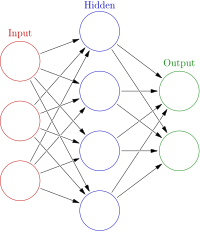
Photo from wikipedia
Implementing any linear transformation matrix through the optical channels of an on-chip reconfigurable multiport interferometer has been emerging as a promising technique for various fields of study, such as information… Click to show full abstract
Implementing any linear transformation matrix through the optical channels of an on-chip reconfigurable multiport interferometer has been emerging as a promising technique for various fields of study, such as information processing and optical communication systems. Recently, the use of multiport optical interferometric-based linear structures in neural networks has attracted a great deal of attention. Optical neural networks have proven to be promising in terms of computational speed and power efficiency, allowing for the increasingly large neural networks that are being created today. This paper demonstrates the experimental analysis of programming a $4\times 4$ reconfigurable optical processor using a unitary transformation matrix implemented by a single layer neural network. To this end, the Mach-Zehnder interferometers (MZIs) in the structure are first experimentally calibrated to circumvent the random phase errors originating from fabrication process variations. The linear transformation matrix of the given application can be implemented by the successive multiplications of the unitary transformation matrices of the constituent MZIs in the optical structure. The required phase shifts to construct the linear transformation matrix by means of the optical processor are determined theoretically. Using this method, a single layer neural network is trained to classify a synthetic linearly separable multivariate Gaussian dataset on a conventional computer using a stochastic optimization algorithm. Additionally, the effect of the phase errors and uncertainties caused by the experimental equipment inaccuracies and the device components imperfections is also analyzed and simulated. Finally, the optical processor is experimentally programmed by applying the obtained phase shifts from the matrix decomposition process to the corresponding phase shifters in the device. The experimental results show that the optical processor achieves 72$\%$ classification accuracy compared to the 98.9$\%$ of the simulated optical neural network on a digital computer.
Journal Title: IEEE Photonics Journal
Year Published: 2019
Link to full text (if available)
Share on Social Media: Sign Up to like & get
recommendations!